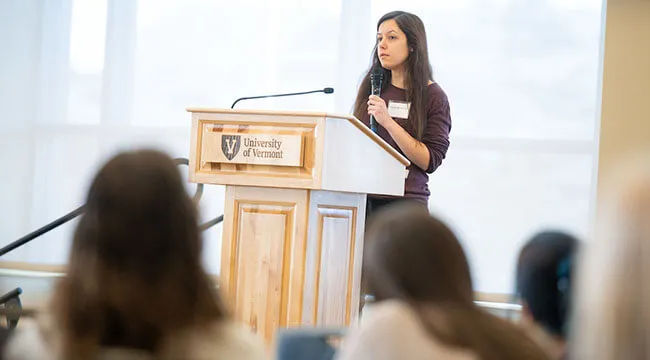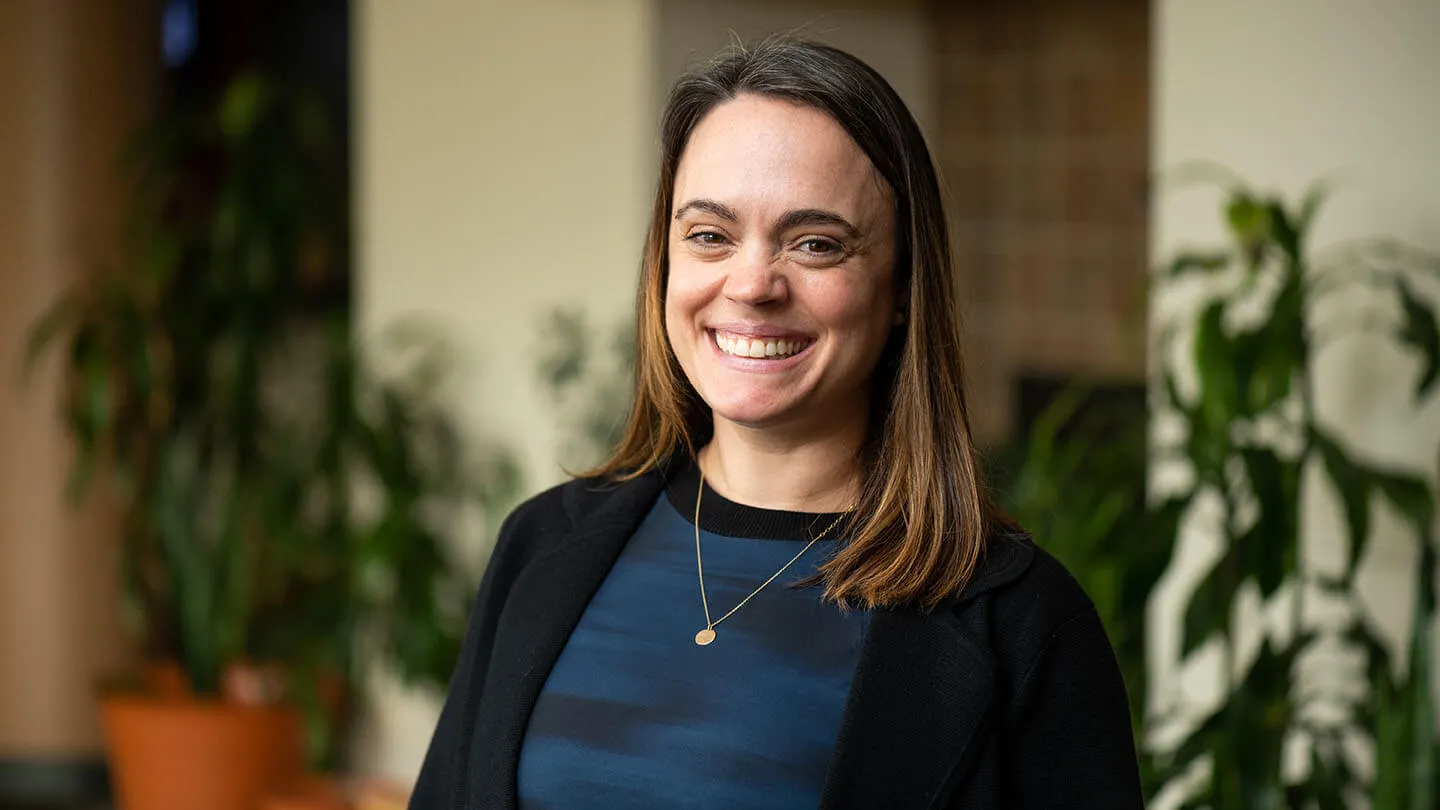Convenience and Connection
Telehealth has been used in some format ever since, and University of Vermont researchers are exploring ways to improve it.
An ongoing qualitative study, led by Elise Tarbi, an assistant professor in the Department of Nursing and member of UVM’s Cancer Center, queries rural Vermonters with cancer about their preferences using telehealth. The team presented preliminary findings Friday, March 7 at UVM Cancer Center’s Scientific Retreat—just weeks before reimbursement for telehealth appointments approved during the Covid-19 pandemic are set to expire.
Telehealth is an important tool for healthcare providers because it increases accessibility for patients, particularly for those living in rural areas, explains Tarbi.
For instance, some individuals in her study are a seven-hour drive from the cancer center, which may limit some caregivers from attending visits and increase discomfort for patients who are already experiencing pain and other symptoms from their illness.
Previous studies have found that telehealth benefits patients across the spectrum and can deliver the same quality of care to palliative care patients, improve medication adherence, and potentially reduce hospital readmission rates for individuals with substance use disorders. Telehealth use peaked in the United States during the Covid-19 pandemic, when many appointments shifted online to limit the spread of disease. Some patients, however, including several in Tarbi’s study, actually prefer receiving care using telehealth.
“It takes a lot of pressure and stress off of them,” says Amelia Haque, a junior nursing student involved with the study.
Improving Telehealth Delivery
Haque is coding participant interviews and helping the research team develop themes from patient conversations. While most patients report finding telehealth appointments convenient, she explains, “a lot of it depends on the patient’s style. It’s all about the specific patient and what they want.”
Haque experienced the benefits of telehealth during the pandemic when she, like many Americans, used video conferencing for the first time for healthcare purposes. She preferred conferring over a screen with a doctor rather than going into a facility and risk exposure when she didn’t have to.
“But if we are deploying telehealth as a healthcare delivery service, we should learn if patients like it and what they do or don’t like about it,” Haque says. “That is what this study is trying to get at the heart of.”
Tarbi’s current study builds on a small pilot investigation she led with researchers from UVM’s Cancer Center, the Vermont Conversation Lab, as well as the Northern New England Clinical & Translational Research Network, that analyzed communication practices to build rapport between patients and palliative care providers during telehealth appointments. The team parsed videoconferences with patients conducted just before the pandemic and Zoom meetings had not yet entered the public lexicon—and found that guidelines used during in-person visits apply across the digital divide, albeit with slight modifications. For instance, using exaggerated physical motions can help individuals feel more connected across screens, and technical difficulties may disrupt conversations, but don’t have to cause them to break down.
“That is an area we can train around,” Tarbi says.
Starting her career as a nurse in intensive care units exposed her to hard and necessary work of having hard conversations with seriously ill patients. In palliative care, learning how to build connections with patients and caregivers is key to improving their quality of life and helping them cope when new health challenges emerge.
“For me, it’s [the] whole reason I went into nursing was to listen to people’s stories,” Tarbi says.
As a member of UVM’s Conversation Lab, which studies communication techniques and interpersonal dynamics that foster human connection, Tarbi examines best practices for interacting with patients both in person and in virtual settings.
There may be times when you can’t give a patient the answer they want, but you can improve how that news is delivered and emphasize what can be done for them, Tarbi explains. “You can learn the words, and that is helpful, but you can also learn to listen and how to connect with a person as a human being.”
She suspects the benefits of telehealth are just being tapped given the audio and video conferencing capabilities. Telehealth encounters could be uploaded to a patient’s electronic medical file and made accessible to their other providers to streamline appointments.
“It can be a hard conversation, and you don’t want to have to have it a thousand times,” Tarbi says.
Enhancing connection and care
Additionally, artificial intelligence could enhance the experience. Imagine a patient receiving a summary of the discussion with their clinician and next steps for care, Tarbi says, and the provider receiving notes on areas for improvement on body language.

There is still a lot of work needed to define what high-quality interaction entails and which metrics to measure, Tarbi acknowledges, but it is a step in a positive direction to improving patient care. That is what Stasha Medeiros, a doctoral candidate in UVM’s Interprofessional Health Sciences program, wants to help Tarbi determine. While interviewing rural patients with cancer she began to wonder: When is a video component necessary? And what, if any, conversations need to happen in person?
One individual in the study mentioned a potential infection that they don’t want to share over an online camera. Other participants mentioned, “‘If I'm going to get some bad news I want to hear it in person,’” whereas others want to receive bad news at home so they can process it better, Medeiros says.
“I would say telehealth is not for everybody, but I think that theme that I've started to gather is that it's definitely useful in part,” she says.
Medeiros presented the team’s preliminary findings in a talk at the Cancer Center’s retreat titled “Why should we all bundle up, drive an hour?”: Connection, communication, and convenience in telehealth serious illness conversations with rural cancer patients.
“Building a connection is possible in a telehealth setting,” she said. “… I don’t want to say that telehealth is always the answer because it’s not.”
But patients in their study seem to value it.
There is no “one size fits all” in telehealth or health care in general, Tarbi explains. Each patient has their own story and requires a tailored approach to care, and for some patients, telehealth is an important component.
“We have to continue to ensure telehealth remains accessible as a part of holistic care that is responsive to people’s needs and preferences,” Tarbi says.
This summer Medeiros hopes to revisit patient conversations with Tarbi to understand how individuals’ comfort with technology may influence their experience with telehealth.
“We have so much data now,” she says, “so let's use it to our advantage.”
